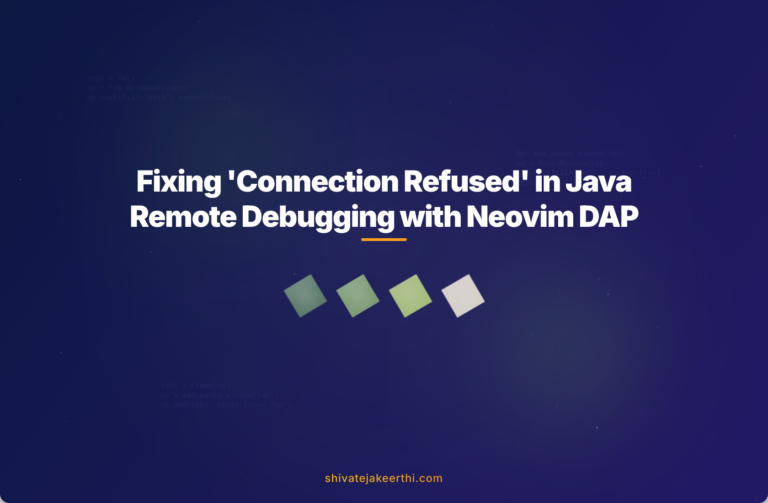When debugging Java applications remotely in Neovim using nvim-dap, one of the most frustrating errors developers stumble upon is the dreaded message: “Connection refused”. This issue halts productivity and blocks developer momentum. Let’s break down this common problem, understand why it happens, and walk through a smooth troubleshooting process to get your debugging back on track quickly.
Understanding Remote Debugging in Neovim
Remote debugging is the process of connecting your debugger to an application running on a remote server or isolated environment. This setup is extremely useful for debugging applications that behave differently in production or staging environments compared to your development environment.
Neovim users benefit greatly here, particularly due to the flexibility offered by nvim-dap (Debug Adapter Protocol client implementation). Nvim-dap allows you to run, pause, and step through Java application code efficiently right from within your Vim environment.
Unlike traditional bulky IDEs, Neovim combined with nvim-dap provides lightweight yet powerful debugging capabilities. Developers appreciate Neovim for its speed, customizability, and seamless integration with various plugins.
Breaking Down the “Connection Refused” Error
You may encounter the message:
Failed to connect to remote VM. Connection refused.
This message typically arises when your debugger tries to connect to a JVM instance running remotely but fails to establish the expected connection. Simply put, the debugger reaches out to your Java application’s debugging port, but no one answers.
Commonly, a connection refused error is caused by:
- Incorrect or closed debugging port: the targeted JVM isn’t listening on the expected port.
- Network issues: Firewalls or networking configurations blocking communication.
- Configuration mismatch: Misconfigured Neovim settings or debugging parameters.
This issue essentially stops your debugging session before you’ve even started. You won’t see variables, breakpoints, or any useful runtime information, leading to wasted effort and developer frustration.
Essential Neovim Configuration for Java Debugging
Getting the configuration just right is crucial in preventing connection refused problems. Typically, Java developers using Neovim rely on the lang.java plugin (nvim-jdtls), paired with nvim-dap for debugging seamlessly.
Your configuration located in init.lua (or your similar Neovim configuration file) should look like this when correctly set up:
local dap = require('dap')
dap.adapters.java = function(callback, config)
callback({
type = 'server',
host = '127.0.0.1',
port = 5005
})
end
dap.configurations.java = {
{
name = "Debug (Attach) - Remote",
type = "java",
request = "attach",
hostName = "127.0.0.1",
port = 5005
}
}
Note specifically the hostName and port values. They must match exactly what your JVM debugging session expects, or the debugger won’t connect.
How I’ve Troubleshot Connection Refused Errors
When encountering a connection refused scenario recently, I went step-by-step to pinpoint the issue precisely. Here’s how I did it:
- I manually started the JVM with the debugging port explicitly specified to check if the JVM accepted debugger connections at all:
java -agentlib:jdwp=transport=dt_socket,server=y,suspend=n,address=*:5005 -jar yourapp.jar
- Once the JVM was up, I manually attached using nvim-dap’s attach command. This worked fine, confirming the JVM and port were both functional.
- Comparing manual and automated initiation, I quickly realized the automated process didn’t correctly configure JVM startup parameters. The core issue was the JVM wasn’t listening for debugging connections due to incorrect initial configuration.
This confirmed the issue wasn’t the environment or networking, but rather related directly to JVM initialization or nvim-dap configuration setup.
Proven Solutions and Workarounds
After pinpointing the root cause, I found adjusting JVM arguments in your configuration was the easiest solution. For instance, when leveraging Maven with Java, editing the pom.xml or build configuration makes it simple:
mvn spring-boot:run -Dspring-boot.run.jvmArguments="-agentlib:jdwp=transport=dt_socket,server=y,suspend=n,address=*:5005"
The key solution here was consistency: use the same debugging settings (port and transport) everywhere, including JVM parameters and nvim-dap configuration.
As a fallback, scripts or aliases designed to run the JVM in debug mode automatically whenever debugging is required simplify ongoing workflow significantly. You’re essentially removing manual steps altogether—for streamlined debugging.
Best Practices for Neovim Remote Debugging
Having addressed this issue thoroughly, here are valuable practices you can adopt to maximize your Neovim debugging experience:
- Consistent debugging configurations: Always ensure your JVM and nvim-dap configuration parameters match perfectly.
- Proper port management: Choose a debugging port that’s unlikely to conflict. Common debugging ports such as 5005 and 8000 are good defaults.
- Use clear error messaging: Regularly monitor JVM logs and terminal outputs to catch and quickly diagnose connection problems.
- Automated JVM startup: Automating the debugging environment saves time, minimizes errors, and enhances productivity.
- Networking checks: Regularly verify your firewall or networking configurations, especially when debugging production/staging environments.
- Refer to Official nvim-dap documentation and relevant Stack Overflow threads if the issue persists.
For further practice, read through community-shared experiences on Neovim debugging at Neovim wiki.
Remember, a little investment upfront in configuring your setup properly usually pays big dividends in reliability down the road.
Remote debugging Java applications with Neovim doesn’t need to be daunting. With care taken in configuration and some clear troubleshooting, those “connection refused” errors become nothing more than occasional annoyances.
Have you overcome similar debugging challenges recently in your Neovim workflow? Share your experiences and tips below—I’d love to hear your insights!



0 Comments